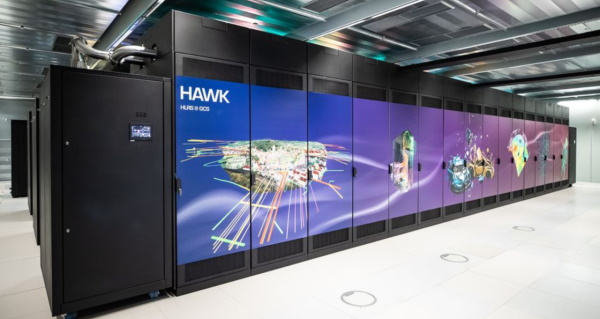 AI
AI
 AI
AI
 AI
AI
The High-Performance Computing Center Stuttgart, known as HLRS, is adding some Nvidia Corp.-powered oomph to its Hawk supercomputer, which is already considered the fastest general-purpose machine for industrial production in Europe.
The Hawk was installed earlier this year and is seen as HLRS’ flagship supercomputer. It’s based on a Hewlett Packard Enterprise Co.-Apollo system and currently ranks as the 16th most powerful supercomputer in the world. It’s also the fastest system in Europe that’s built purely on a central processing unit architecture.
That will soon change, though, as Hawk is about to be turbocharged with 192 of Nvidia’s latest A100 graphics processing units linked via a Mellanox InfiniBand network. The A100 was launched earlier this year and is said to be 20 times more powerful than Nvidia’s previous GPU, the Volta. It’s designed for the most advanced artificial intelligence, data analytics and cloud-based graphics workloads.
HLRS said the expanded Hawk supercomputer will be used for research projects that range from predicting the spread of COVID-19 to doing the science behind building better cars and airplanes.
“Humans can create huge simulations, but we can’t always understand all the data,” said HLRS Director Michael Resch. “The big advantage of AI is it can work through the data and see its consequences.”
HLRS already has one Nvidia-powered AI supercomputer, a Cray CS-Storm system installed in 2019 that’s powered by 60 Nvidia Volta GPUs. It’s used to run AI programs that analyze market data for Mercedes-Benz AG, a large German investment bank and other customers.
Resch said customers were demand even greater AI processing power, hence the decision to update Hawk. The enhanced machine will be able to power hybrid computing workloads, with GPUs and CPUs working in tandem on high-performance computing simulations with AI. “Combining the two is a golden bullet that propels us into a better future for understanding problems,” Resch said.
The University of Stuttgart is planning to use Hawk to train neural networks that can evaluate the quality and economic value of metal alloys, based on data from more than 2 billion simulations. It said the AI model it develops will be able to run on a standard personal computer and help companies that produce sheet metal to choose the best alloys for different products, such as a car door. “This is extremely helpful in situations where experimentation is difficult or costly,” Resch said.
Other projects earmarked for the beefed-up Hawk include an analysis of fluid dynamics data by a team of researchers from Stuttgart University. The idea is to train neural networks on data from simulations in order to create an AI model that can improve turbulence analysis. Tat will be useful for Airbus SE, the European aerospace corporation, which is collaborating with HLRS to mine its airflow data for better insights.
Another project will use AI to predict when hospital beds are likely to fill up in intensive care units from coronavirus cases, helping experts manage capacity more effectively. The goal of the project is to give policy-makers a four-week window to respond before maximum capacity is reached.
“It’s a critical question with so many people dying,” Resch said. “We’ve seen scenarios in places like Italy, New York and Wuhan where ICUs filled up in the first weeks of pandemic. So we will conduct simulations and predictions of the outlook for the pandemic over the next weeks and months, and GPUs will be extremely helpful for that.”
THANK YOU